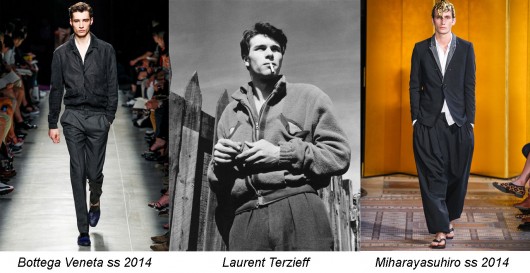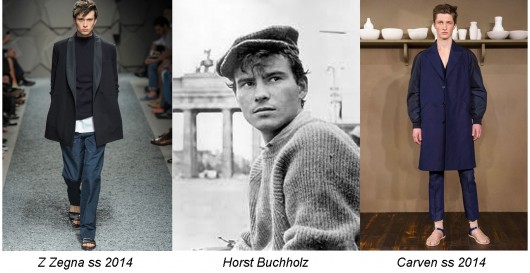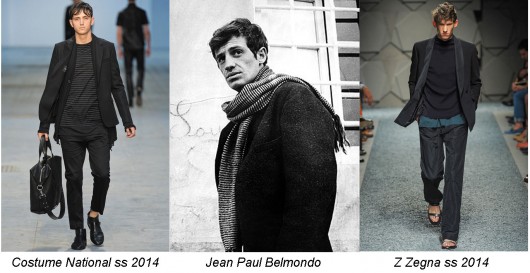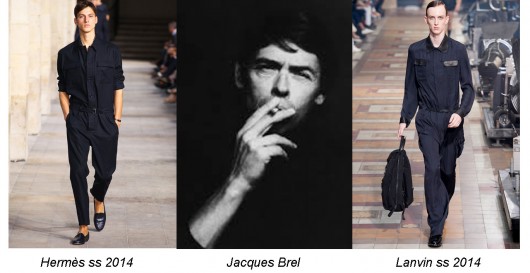ESISTENZIALISMO IN PROGRESS
Non si tratta semplicemente di un dolcevita nero. L’esistenzialismo, a cui la moda Uomo di queste stagioni pare volersi richiamare, non è solo una questione di look, è molto di più: rimanda a quel grande fenomeno culturale che fu un momento decisivo nel mutamento degli orizzonti spirituali per il mondo intero e per quello Occidentale in special modo. A partire dalla fine della Seconda Guerra Mondiale, dal momento della Ricostruzione materiale e civica dell’Europa, finalmente i giovani hanno voce in capitolo, quantomeno nelle metropoli europee, a Parigi in primo luogo, ma anche nelle grandi città tedesche ancora in macerie. Anche perché la generazione precedente è stata decimata dal conflitto e si ritrova disorientata. Passa la staffetta a chi ha vissuto la catastrofe da bambino e prova un desiderio forte di aria nuova, un bisogno incontenibile di cambiamento radicale nel modo di concepire la vita.
L’Esistenzialismo vanta padri nobili. Sul piano della filosofia, della letteratura, della musica, del teatro, del cinema. Ed antenati non meno illustri. Tra i primi: Jean Paul Sartre e Karl Jaspers, Albert Camus, Juliette Greco e Jacques Brel, Eugene Ionesco, Ingmar Bergman. Tra i secondi: la Scapigliatura milanese e i “poètes maudits” francesi di fine ‘800. Può essere interessante anche il parallelismo, quantomeno in termini di aspirazioni, con la “beat generation” americana, da Kerouac a Ginsberg. Stesso, prorompente anelito di libertà, di rottura, di anticonformismo, di ribellione, di trasgressione. Un parallelismo che però non è totale: gli Esistenzialisti vivono tutto ciò in modo più…estenuato, smaliziato, malinconico, carico di maggiore “ennui”. In una parola, in modo più europeo. Manca la sintonia anche in fatto di stile. I “giovani ribelli” d’Oltreoceano si accontentano di tagliarsi un po’ meno spesso i capelli, abbondano nell’uso di camicie a scacchi da rodeo del Mid West, di jeans più che sdruciti, di giacche di velluto informi, vagando per il Paese su enormi automobili malconce.
Europei d.o.c., gli Esistenzialisti sanno invece elaborare un proprio lessico vestimentale. Nelle “caves” parigine, valgono codici estetici ben precisi. Sono inediti, ma ci sono. E sono imperativi. In alternativa alla camicia vengono sdoganati i pullover portati a pelle: dolcevita o meno, neri o meno, anche se questo non-colore prende piede e si svincola dall’uso esclusivo per la sera, la cerimonia e il lutto. Così come vengono sdoganati il montgomery o il raincoat più corto e più facile rispetto al trench tradizionale. Le ragazze possono finalmente indossare i pantaloni anche in città, non solo sulle piste da sci. Le giacche possono essere “fitted” o “loose”, ma appaiono sempre un po’… pre-decontracté, per nulla “stiff”. Chi osa maggiormente adotta la tuta, quasi da cosmonauta sovietico, a testimonianza della volontà di guardare al futuro prossimo venturo. Certamente, gli Esistenzialisti non resistono all’appeal dei jeans e dei blouson che arrivano dagli States, ma li integrano con cura nel proprio lessico. In parallelo, si impone lo scooter che diventa il mezzo di trasporto giovane per antonomasia in un continente intero. In barba ai macchinoni “made in USA”.
Giungendo al presente, è facile notare come l’essenzialità di sapore esistenzialista di molte collezioni Uomo risulti felicemente compenetrata dall’hi-tech. Perché essenzialità vuol dire anche comfort e vestibilità più agevole, garantiti dalle nuove elaborazioni materiche, dall’ottimizzazione delle textures nella loro resa, nelle loro performance e nelle loro possibilità di impiego. In sintesi: ora nel menswear l’esistenzialismo si coniuga senza stridori con una sorta di …futurismo. Del resto, la moda da sempre pensa in progress e vive di commistioni, per questo gli “ismi” convivono pacificamente. Facendo della moda stessa qualcosa di davvero unico, costantemente in divenire. Giorgio Re
It’s not only a black turtle neck. Existentialism, which s/s menswear seems to recall, it’s not only a matter of look: it’s an important culture phenomenon, a decisive moment of change of spiritual horizons for the whole world, especially for the Occidental one. Since the end of the Second World War, in an era of reconstruction, finally young people have a voice in, at least in european cities, first of all Paris, but in big german cities still in ruins too. Also because the previous generation has been decimated by the conflict and find itself lost. It passes the baton to whom lived the disaster as a child and hungers for a wind of change. Existentialism has noble fathers. On philosophical, literary, musical, theatrical, movie footing. And has noble forebears. Among the first ones: Jean Paul Sartre and Karl Jaspers, Albert Camus, Juliette Greco and Jacques Brel, Eugene Ionesco, Ingmar Bergman. Among the second: milanese Scapigliatura and the french “poètes maudits” of the end of the Nineteenth century. It can be interesting a parallelism with the american “beat generation”, from Kerouac to Ginsberg. The same bursting longing for freedom, break, unconventionality, rebellion, transgression. A parallelism that is not complete: Existentialists live this in a more drastic, cunning, mournful way. In a word, in a more european way. There’s a lack of sync in style too. The “young rebels” of the USA get satisfaction in cutting their hair rarely and wearing a lot of checked shirts, more than torn jeans, shapeless velvet jackets, wandering around the Country driving huge battered cars. As real europeans, Existentialists know how to develop their own style lexicon. In parisian “caves” there are very precise, innovative, standards of beauty. That are imperative. As an alternative to shirt they sanction the pullover worn on the bare skin: turtleneck or not, black or not, even if this non-colour becomes a must and releases from the sole use for evening, ceremonies and grief. In the same way they sanction the duffel coat and the raincoat, shorter and easier than the traditional trench. Girls can finally wear trousers in the cities, not only on ski slopes. Jackets can be “fitted”or “loose”, but they always look a little…pre-decontracté, “stiff” at all. Who dares mainly wears the overalls, nearly as the soviet cosmonauts, as a proof of the will to look forward. Certainly, Existentialists don’t resist to the appeal of jeans and blousons from the States, but they include them with care in their lexicon. At the same time the motor-scooter becomes the main means of trasport of young people. In spite of the big cars “made in USA”. Coming to present, it’s easy to notice how simplicity, inspired by existentialism, of many menswear collections is successfully corrupted by hi-tech. Because simplicity means also comfort and easier wearability, guaranteed by new materials, maximisation of textures in terms of performances and uses. To sum up: in menswear existentialisms combines with a kind of…futurism. Moreover, fashion has always thought in progress and lives on connections, this is why “isms” coexist peacefully. Making fashion itself a very unique and in continuous evolution thing. Giorgio Re









